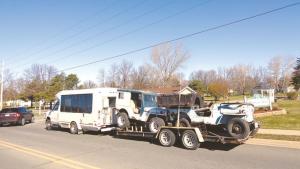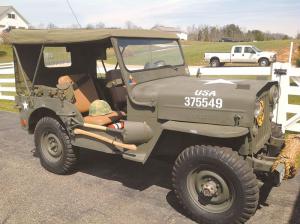2017 - Volume #41, Issue #4, Page #06
[ Sample Stories From This Issue | List of All Stories In This Issue | Print this story
| Read this issue]
He Gives Old Jeeps New Life
 |
 |
“The 60 hp., 4-cylinder, flathead gas engine is simple to work on and tough as nails,” says Nelson. “If you have spark, some compression and gas, they’ll run forever. The challenge is finding them. There are fewer every year.”
Often times the engine is frozen from sitting around for years. To unfreeze an engine, Nelson likes to use diesel fuel in the cylinders. “It works slow, but if they break loose, they are oiled right away,” he says.
He suggests hanging a pail of rocks on the end of a 10-ft. pipe attached to the crank. “Leave it there to pull steady for a few days, and then if you’re lucky, one day the bucket will be on the ground,” says Nelson.
Occasionally he does have to add a set of piston rings. To create the replica WWII look, tailgates are replaced with steel plates, and the spare tire is moved from the side to the back. The big enemy is rust. It takes a lot of sandpaper, wire wheels, and his secret weapons, toilet bowl cleaner and water.
“The cleaner eats the rust away,” says Nelson. “I’ll stick moving parts that are rusted up in water for a day, and that frees them up.”
Nelson, a self-described “wrencher” since high school, has bought and sold cars his entire life. For a number of years he restored tractors, but it was hard to make any money on them. A little over 4 years ago, he bought a WWII era Jeep, fixed it up, and sold it for a profit. He’s sold another dozen replica Jeeps since, with others he has purchased going for parts.
“I’ve got 3 that I bought recently, and 2 may get restored,” he says.
Sometimes the right parts make the Jeep worth buying, explains Nelson. In one case, a seller told him about a Jeep that had been in storage for 26 years. In fact, the back half had been “stored” in a creek and was terribly rusted. The front half was in better shape as it was sticking out of the water.
“I bought it because it had the original 16-in. wheels on it,” says Nelson. “They’re hard to find because most people switched to 15-in. rims so they could use car tires.”
Nelson carefully goes through each Jeep he plans to sell to be sure it is safe to drive. He makes them as authentic as possible, even welding on handholds around the body of the Jeep. They were commonly added during the war so soldiers could help pull a stuck Jeep out of the mud.
His replica Jeeps have been shipped to France, Norway, England and Mexico, as well as around the U.S. He has purchased Jeeps and parts from Michigan to the west side of the Rockies and from Canada to Oklahoma. He’s still looking.
“If FARM SHOW readers have an old Jeep to sell or know of one or even just parts, give me a call,” says Nelson. “I’m always looking.”
What he pays depends on the condition. Purchase prices generally range from $800 to $2,000, with the high end being for one in pretty good shape.
“I just paid $400 for one, but it had a wood top that looked like heck, the motor was frozen so it will take a lot of work,” says Nelson.
Most restored WWII Willys Jeeps sell in the $7,000 to $9,000 price range, but that too can depend. “Back in February a nice one with a trailer sold for $21,000. I just sold one with a trailer that was even nicer, and it only brought $9,000.”
Contact: FARM SHOW Followup, Jon Nelson, Deckslider, 12329 County Road 8 SW, Stewartville, Minn. 55976 (ph 507 533-4815 or 507 202-3794; deckslider1@gmail.com).

Click here to download page story appeared in.

Click here to read entire issue
To read the rest of this story, download this issue below or click here to register with your account number.




